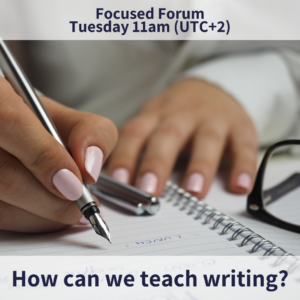This was an interesting chat as we discussed some of the issues around writing as well as coming up with a few practical ideas to work on this skill in the classroom. To begin with, we talked about an issue here in Spain which affects not only writing skills, but other aspects of learning English too: the backward shift for students in the final year of primary when they move into secondary. One participant noticed that in the final year of primary, students are exposed to a wide variety of text types and can often have a B1 level of English, but then start secondary working at a much lower level of English, with more limited input and expected output.
Another issue we identified is that students are often not taught to write different text types in their first language, meaning that more work needs to be done identifying features of a particular genre. We talked a little about the difference between a product and process approach, and suggested that a product approach often misses out the noticing stage to raise learners’ awareness of genre features.
We suggested that students could be given better frameworks to support them in writing, identifying the features of the text type and, when the writing is to be assessed, giving explicit instructions on how the text is marked and what should be included. For example, the rubric might explicitly ask for a particular grammatical structure to be included in order for the teacher to assess the student’s use of that linguistic point.
When preparing students for writing in exams, we suggested working with bad models of text as well. These are often included in exam handbooks, along with the marker’s feedback. However, we also noted that at lower levels, this might be a less effective approach as they may struggle to identify errors in the original.
We felt improving a text might be a good collaborative activity as it gives the students a starting point rather than a blank page to work on. Other ideas for collaborative activities included story writing – and perhaps using an app such as Storybird to bring the book to life – and a focus on planning a text together, but then writing the finished product individually.
A couple of other points we touched on were about raising students’ awareness of the difference between spoken and written communication and also writing conventions – across languages and cultures and different deliveries. For example, we chatted about the fact that Spanish writing tends to involve a lot of long sentences or the fact that punctuation is very different in text messaging than in formal writing, including the idea that using a full stop at the end of a message is considered rude!
